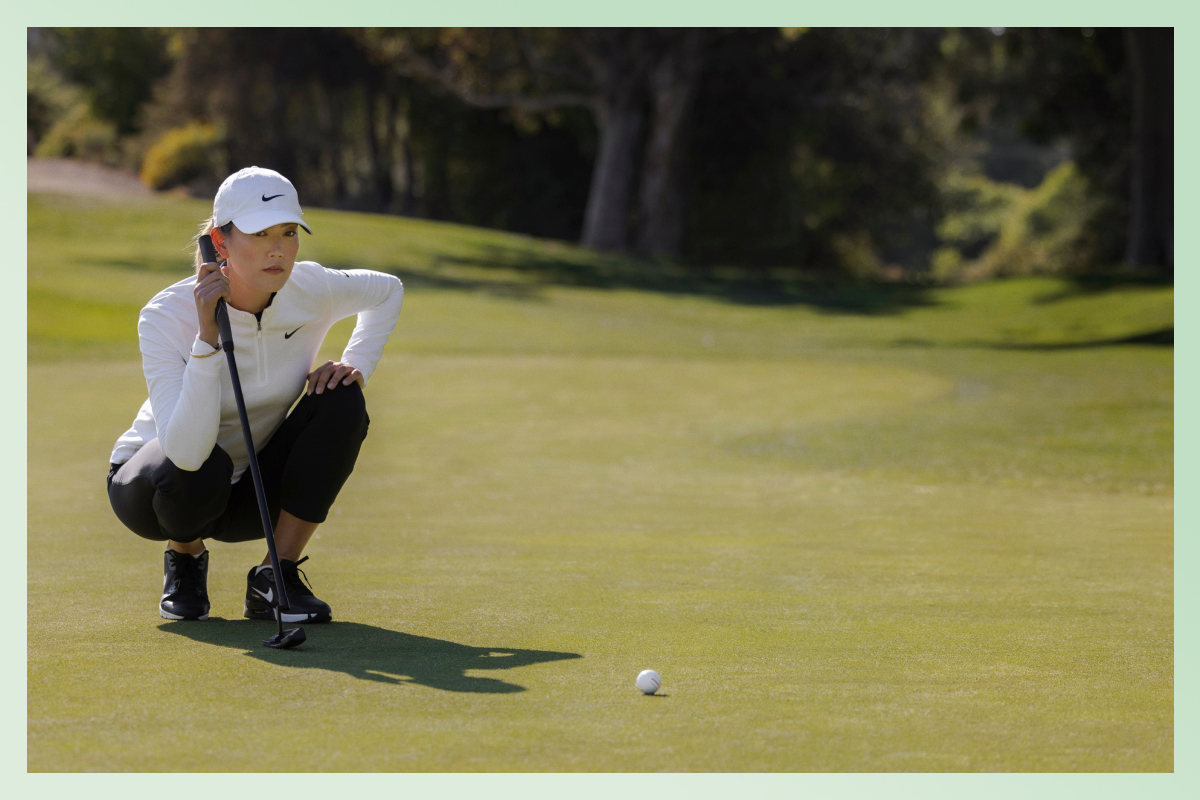Heed this advice when you’re shooting par or better.

Whether you’re an occasional golfer or an avid one, you need lots of practice if you want to be any good. And according to golf champion Michelle Wie West, practice doesn’t need to only happen at the range. Adding the appropriate movements to your resistance training can all pay big dividends on the links.
“Doing the right workouts is important,” says Wie West. “No matter how avid or recreational you are, unfortunately, golf is not your day job. So there are going to be moments when you can’t get out to the range. Golf is about muscle memory and getting the right motion down, and you can get those motions down on Tonal.”
Pulling your golf training into your workout routine is an essential strategy for improving in a sport where strategy, the experts say, is just as important– if not more–than driving the long ball. “Strategy starts with understanding all the variables in both your golf game as well as the actual golf course,” says Frederick Moore, PGA member and Director of Instruction at Game On Golf Center in White Plains, NY. Here, top golf experts like Moore share their golf tips and strategy secrets to help you take your game to the next level.
Play from the proper tees
Many players (not just beginners) unintentionally play from the wrong tees, which not only leads to an added challenge on the course but can also hold up groups playing behind you. Fortunately, there’s a math equation for that.
“The formula for playing the proper yardage, or tees, for any golf course is to multiply your 5-iron carry distance by 36—this total number is the maximum yardage at which you can play a comfortable game of golf,” explains Moore.
For example, if you have a 170-yard 5-iron carry, multiply that by 36, which comes out to 6,120 total yards. “This would eliminate the ‘back tees’ on any golf course and most men’s regular tees as well,” says Moore. Knowing your total yardage will help you determine the correct tees for you.
Make club selection part of your strategy
Club selection can play a big role in your overall game. “The driver is not always the best choice off the tee,” says Moore. He recommends most intermediate or advanced players to become better drivers with their 3 wood, so that, “one, they have a ‘backup plan’ when the driver is acting up, and two, because the 3 wood tends to curve less to both the left and right due to having more loft and a shorter shaft.”
Having a plan for every hole of the course you’re playing is a part of the strategy as well, so Moore suggests doing some research before you arrive. “You’ll want to check the course layout and tee length, as well as the green complexes and green speeds,” he says. Arming yourself with knowledge ahead of time can serve you well during gameplay.
Work on generating more club speed
Speed or interval training, during which you’re focusing on explosiveness, is very specific, and the only way to train for speed is to move fast, says Max Artsis, certified trainer and Tonal Sports Performance Specialist. He recommends workout sessions strictly dedicated to club speed training.
“Our mind is typically a governor that slows us down. It takes training to turn that governor off and allow you to swing as fast as possible,” he explains. “Speed sticks are a great tool for that, specifically for golf, but any speed training will help your nervous system become more equipped for handling high-speed movement in general.”

Prioritize your long game
The three scoring clubs in golf are the driver, the wedge, and the putter. Out of the 18 holes on a course, you’ll likely drive the ball on 12 to 14 of them, which is why becoming a better driver of the golf ball is a top priority. The better your placement and distance off the tee, the better chance you’ll have of hitting the green in regulation.
“Understanding the difference between driving the golf ball off of a tee and hitting it off the ground with an iron is the first step, and this needs to be realized and practiced repeatedly,” says Moore.
Driver distance is the function of three factors: clubhead speed, centeredness of contact, and angle of approach of the clubhead to impact. “All three of these factors, as well as developing the proper inside path of the clubhead and proper clubhead rotation to achieve the proper path/face relationship at impact, are important in becoming a great driver of the golf ball,” Moore explains.
Develop explosive power with strength training

If you want power, you need to strength train using moves that will develop explosiveness. “There is a direct correlation to squat power and your drive distance,” explains Artsis, “so I highly recommend getting those numbers up, as well as jump height.”
Golf is really about torque and sequencing. “I have seen [golfers] that look like I should outdrive them by 40 yards do just that to me,” says Artsis. “They use the ground better, understand how to create a ‘whip’ from their body, and generate more torque, so I think that mobility work and getting strong in your extended ranges of motion are crucial.”
Tonal offers a holistic Golf-specific program that includes workouts inspired by Wie West’s training and her pro tips, as well as yoga and mobility workouts for golfers, and meditation sessions. All of this can help you build both physical and mental strength and improve your mobility when you’re training off the course. Or check out this list of exercises that will help you crush your drives off the tee.
Identify weaknesses in your short game
Your short game consists of about 60 to 70 percent of the total strokes you’ll make in a round of golf. That includes putting, chipping, pitching, greenside bunker shots, and all wedge play within 100 yards of the green. In order to improve your short game, Moore says you must first identify your weaknesses.
“When I attack a good player’s short game, I keep track of total putts, up and down percentage, sand saves, and of course, proximity to hole on first putt when a green is missed, which is all key to analyzing where weaknesses lie,” he says. “Once weaknesses are identified, then skill acquisition through lessons and practices becomes necessary.”
Don’t follow up a bad shot with a bad decision
For the majority of golfers, poor decision-making will cost far more strokes than an inability to play the game. Being able to visualize your shots is important as well. “There is an amazing thing that happens to the body when the hippocampus and amygdala parts of the brain work together—they help to influence subconscious decision-making,” Artsis says. “Positive self-talk and strong visualizations can do absolute wonders for any athlete.”
Tonal offerings go beyond the workouts you need to build physical strength and power for golf; they also include meditation sessions (like “Breathe to Focus the Mind”) that can help you build mental strength, as well. Practicing your ability to focus and stay calm under pressure when you’re off the course will help you find consistent success when you’re on the course.


